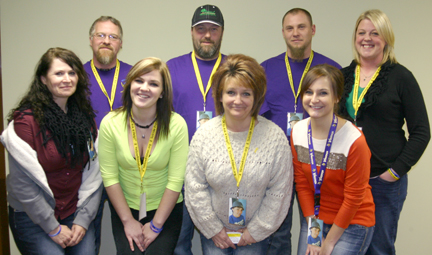Robert had met two parents in Colorado who also lost a child to suicide. When their tragedy occurred, the kids in the community asked them what they could do to help. The biggest thing those parents wanted the kids to know was to always ask for help if you’re even thinking about suicide. With that message in mind, they printed 500 cards and mailed them out to students around the country. One of the students who received a card was the student who shared it with her school counselor, mentioned above.
Robert went on to explain how the family got involved with the program. He thanked his sister, Darcy, for getting our community’s program up and running. “We have her to thank for what’s going on now,” Robert said.
It was obvious that the next part of his speech was difficult for Robert, but the emotions in his face and voice when he talked about Jacob were enough to make me want to do everything I can do prevent any future suicide. I lost a best friend to suicide, but I can’t imagine what it would be like to lose a child to it.
Robert then let Darcy speak her piece before she shared an informational powerpoint presentation about the program, preventing suicide, warning signs, risk factors, myths, statistics, and protective factors.
“Everyone in this room is going to be affected by suicide, either directly or indirectly,” Darcy said. Whether it be a friend, or a friend of a friend. Some of us have already been affected by it. She then stressed that their goal was to prepare the community so that another tragedy doesn’t occur.
“Suicide is preventable,” Darcy said, “and everyone needs to be aware and trained.”
Suicide is a sensitive topic. People avoid it by saying things like, “Talking about it will plant ideas in the kids’ heads and make them more likely to do it,” or “It’s a sensitive subject that isn’t appropriate to talk about.” But talking about it is the only way to prevent it. It’s obviously a problem: it’s the third biggest killer in our country. “We don’t want to talk about it,” Darcy said. “It’s scary. But the more we talk about it, the easier it becomes.”
After going through the power point presentation, Jeff Howe, Robert’s brother, stepped up to explain the “Ask for Help” cards. The cards are the same as the ones students in Colorado made, and they serve a very important purpose. Teachers, bus drivers, doctors, or any other non-judgmental and reassuring people that children or teens see regularly should have many of these cards on hand for kids to take. If they need help and don’t know how to ask, they can give the card to a trusted adult. If you are given one of these cards, the most important thing you need to know is that you are this person’s lifeline. They came to you because they need help and feel they have no where else to turn. Staying with this person is vital. Then, get or call for help immediately.
Robert then took over again with a conclusion. He stressed that although suicide is higher among young adults, people of any age can suffer from suicidal thoughts/actions.
“Pain doesn’t know an age,” Robert stated, “and some people are very good at hiding it.”
There will be many more meetings at local churches, schools, and other places that involve members of the community. The more people that are educated in the topic, the more likely we are to prevent it. Nobody should have to experience a tragedy as great as suicide, and with your help, we can stop it from happening again.
Robert ended the meeting by thanking everyone, and everyone received “Ask for Help” cards. The friendly team in charge was so thankful to see everyone that showed up, and hope to see a positive reaction from the community as they continue to introduce their program.

